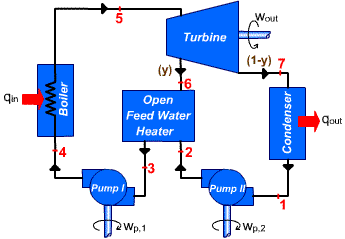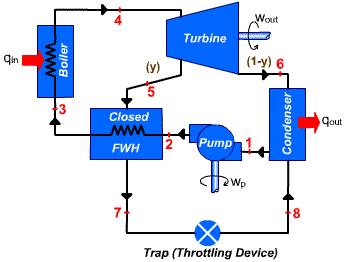Increasing the boiler pressure increases the thermal efficiency of the
Rankine cycle, but it also increases the moisture content of the steam.
To overcome the problem:
- modify the simple ideal Rankine
cycle with a reheat process
- expand the steam in the turbine in two stages, and reheat it in between
In the first stage (the high-pressure turbine), the steam is expanded isentropically to an intermediate pressure and sent back to the boiler where it is reheated at constant pressure, usually to the inlet temperature of the first turbine stage.
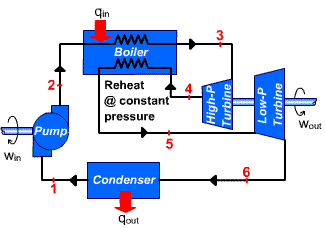 |
 |
Steam then expands isentropically in the second stage (low-pressure turbine) to the condenser pressure.

The reheat process, in general, does not significantly change the average temperature at which heat is added. Therefore, the cycle efficiency is not influenced greatly by the reheat process.
The sole purpose of the reheat cycle is to reduce the moisture content of the steam at the final stages of the expansion process.
|
Heat addition to the working fluid during the process (2-2') at a relatively low temperature lowers the average temperature at which heat is added and thus the cycle efficiency. To overcome this shortcoming is to extract steam from the turbine at various points. This steam, which could have produced more work by expanding further in the turbine, is used to heat the feedwater instead. The device where the feedwater is heated by regeneration is called a regenerator. |
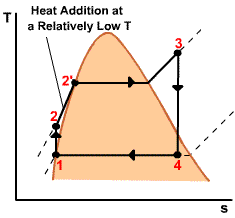 T-s Diagram of the Ideal Rankine Cycle |
|
Advantages
of Using Heat Regeneration
|
| 1. It improves the cycle efficiency |
| 2. It provides a convenient means of deaerating the feedwater (removing the air that leaks in at the condenser) to prevent corrosion in the boiler |
| 3. It also helps control the large volume flow rate of the steam at the final stages of the turbine |
An open feedwater heater is basically a mixing chamber, where the steam
extracted from the turbine mixes with the feedwater exiting the pump.
Ideally, the mixture leaves the heater as a saturated liquid at the heater
pressure.
The average temperature during the reheat process can be increased by increasing the number of expansion and reheat stages. As the number of stages increases, the expansion and reheat processes approach an isothermal process at the maximum temperature. The optimum number is determined by economical consideration.
|
|
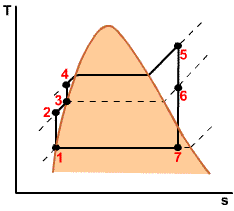 |
For each 1kg of steam leaving the boiler, y kg expands partially in the turbine and is extracted at state 6. The remaining (1-y) kg expands completely to the condenser pressure.
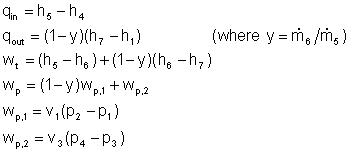
The cycle efficiency increases as the number of feedwater heaters is increased. Many large plants in operation today use as many as eight feedwater heaters. The optimum number of feedwater heaters is determined from economical consideration.
For closed feedwater heaters, heat is transferred from the extracted steam
to the feedwater without any mixing taking place. Since they do not mix,
the two streams can be at different pressure.
In an ideal closed feedwater heater, the feedwater is heated to the exit temperature of the extracted steam, which ideally leaves the heater as a saturated liquid at the extraction pressure. The condensed steam is then either pumped to the feedwater line or routed to another heater or to the condenser through a device called a trap. A trap allows the liquid to be throttled to a lower pressure region but traps the vapor. The enthaply of steam remains constant during this throttling process.
|
|
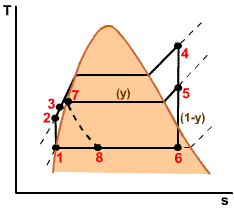 |
|
Open
Feedwater Heaters
|
Closed
Feedwater Heaters
|
|
| Simple | Complex | |
| Inexpensive | Expensive | |
| Good heat transfer characteristics | Less effective in heat transfer | |
| Require a separate pump for each heater | Do not require a separate pump for each heaters | |
